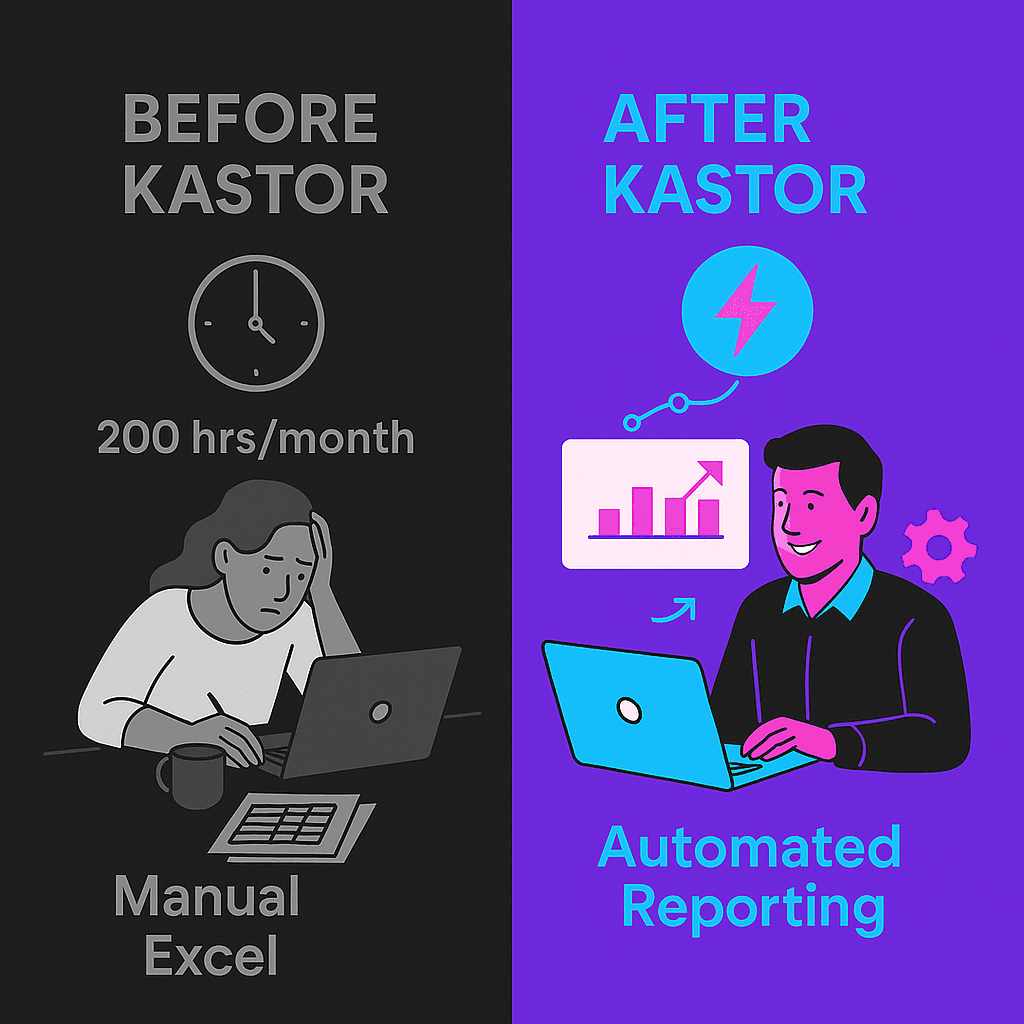Unlock the Power of Automated Reporting for Your Business
Data isn't just growing—it's evolving. But too many teams are stuck with outdated tools, fragmented systems, and insights that arrive too late to matter.
Modern data infrastructure—powered by technologies like Iceberg, AI, and natural language processing—is reshaping how businesses manage, access, and act on their data. The shift isn’t just technical—it’s strategic. Organizations that adapt are faster, smarter, and more resilient.
Ready to simplify your stack and accelerate your insights? Discover how Kastor can transform your data operations.

Did you know that 80% of businesses struggle to transform their data into actionable insights? This staggering statistic highlights a common challenge in the corporate world today—making sense of massive datasets and translating them into strategic actions. The importance of automated reporting has never been more pronounced. By adopting robust automated reporting strategies, businesses can eliminate bottlenecks, save time, and access reliable insights for informed decision-making. In this comprehensive guide, we will explore the infinite possibilities of automated reporting, how it can streamline your business workflows, and why it is crucial in today's data-driven landscape. Get ready to transform your data management operations!
Understanding Automated Reporting
Automated reporting refers to the process of generating reports with minimal manual intervention. Through advanced technologies, data sources can be integrated seamlessly, and the reports can be curated on a set schedule or triggered by specific events. This approach not only improves efficiency but also allows for real-time data visibility.
Benefits of Automated Reporting
- Saves Time - Traditional reporting can be time-consuming, often requiring significant manual effort to compile data, analyze it, and present findings. Automated reporting allows teams to generate reports in minutes, freeing them to focus on strategic initiatives.
- Enhances Accuracy - Human errors in data entry and analysis can skew outcomes. Automating the reporting process mitigates these risks by providing consistent accuracy based on up-to-date data inputs.
- Increases Reliability - With real-time updates and scheduling options, automated reports ensure that decision-makers are equipped with the most current data at their fingertips, leading to more confident and timely decisions.
- Improves Decision-Making - By providing quick access to critical information, automated reporting enables leaders to make informed decisions faster, thus holding a competitive advantage.
Setting Up Automated Reporting Systems
Implementing automated reporting involves several steps:
- Identify Goals: Understand what insights are necessary for the team and define clear objectives for the automated reporting system.
- Choose the Right Tools: Select the right automation tools that align with your data architecture. Consider platforms that offer integrations with existing tools and provide functions like data visualization, easy reporting formats, and scheduling capabilities.
- Integrate Data Sources: Ensure that the data sources—be it databases, CRM platforms, or marketing analytics tools—are properly integrated for comprehensive reporting.
- Customize Report Formats: Tailor the report formats to fit the audience. Some reports might need to be high-level for executives, while others may require intricate details for analysts.
- Test and Optimize Automation: Before going fully live with automated reporting, test the reports for accuracy and efficiency. Gather feedback from the end-users and make necessary adjustments to optimize the process.
Overcoming Challenges in Automated Reporting
Despite its benefits, organizations may face challenges in launching automated reporting. Here’s how to address them:
- Data Quality: Automating reports is only as effective as the data behind them. Invest time and resources into ensuring high-quality data management processes.
- User Adoption: Change can be difficult; hence, it’s crucial to train employees on using new tools and understanding the importance of automated reporting.
- Technology Limitations: Not all tools can take on automation. Conduct thorough research to find the tools that align with your strategic goals and infrastructure.
Examples of Effective Automated Reporting in Action
- Financial Reporting: Banks and financial institutions utilize automated reporting to continually generate balance sheets, income statements, and other critical data to meet regulatory requirements.
- Marketing Analytics: Marketing firms leverage automated reporting to create dashboards that provide insights on campaign performance metrics—all updated in real time.
- Sales Tracking: Real estate companies automate reports for listing activities and market trends, highlighting potential deals to accelerate decision-making.
Transform Your Business Today
By automating your reporting processes, you will not only streamline workflows but will also empower your team to focus on high-priority tasks instead of spending hours on report generation. Moreover, utilizing this technology means that every part of your workflow becomes interconnected, leading to an optimized ecosystem that drives better outcomes across departments.
Transform your data management with Kastor—the intelligence your business needs. Book a demo today to experience firsthand how seamless automated reporting can elevate your strategic decisions. Book a Demo